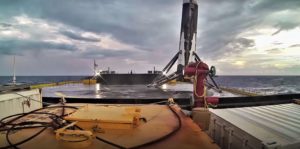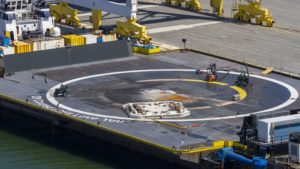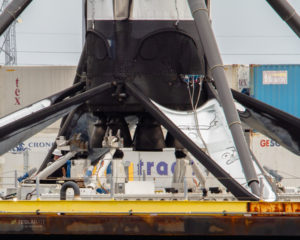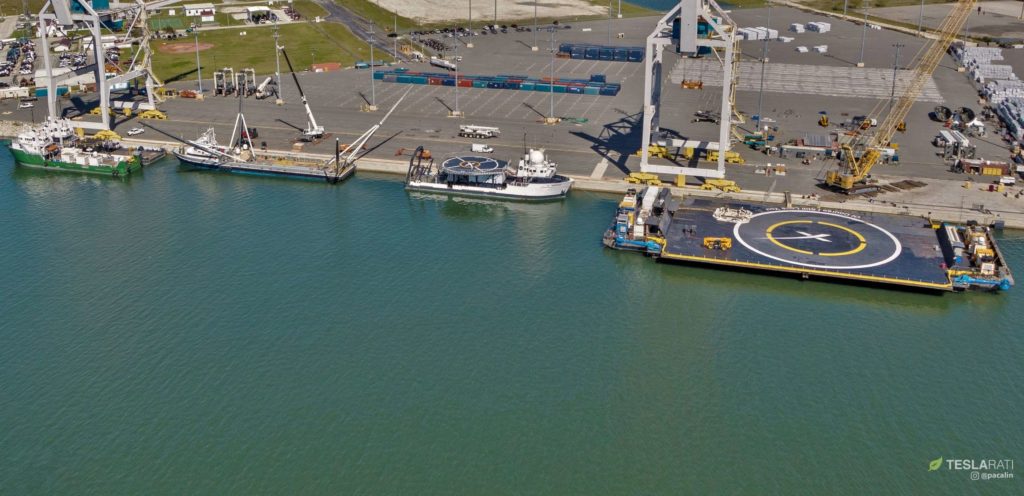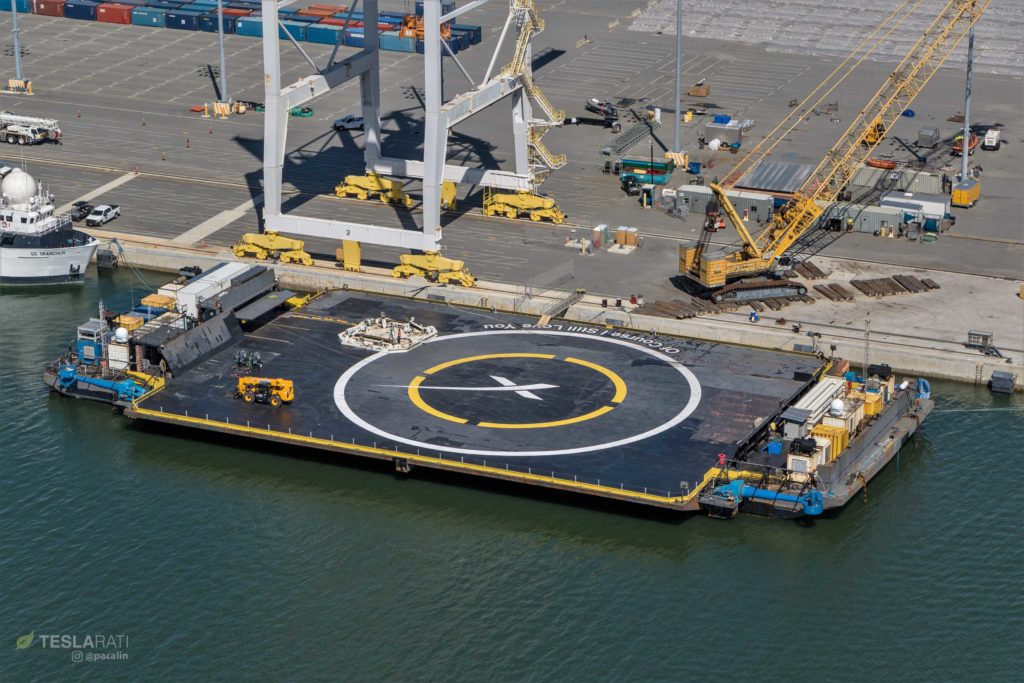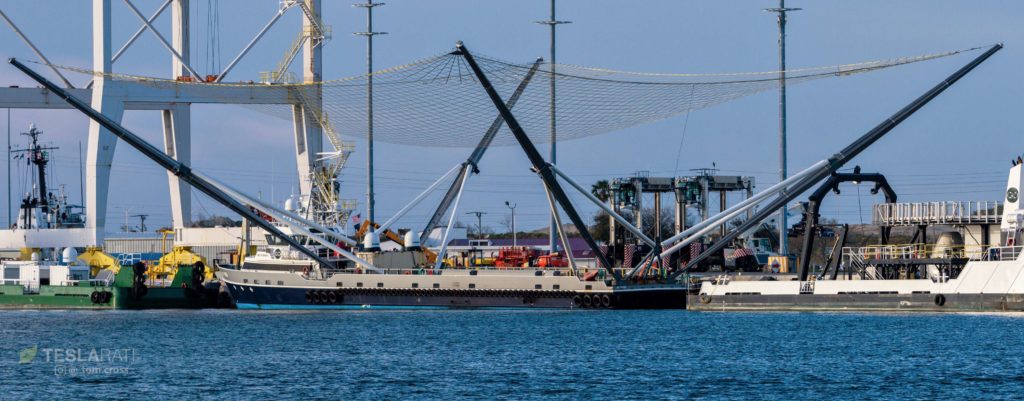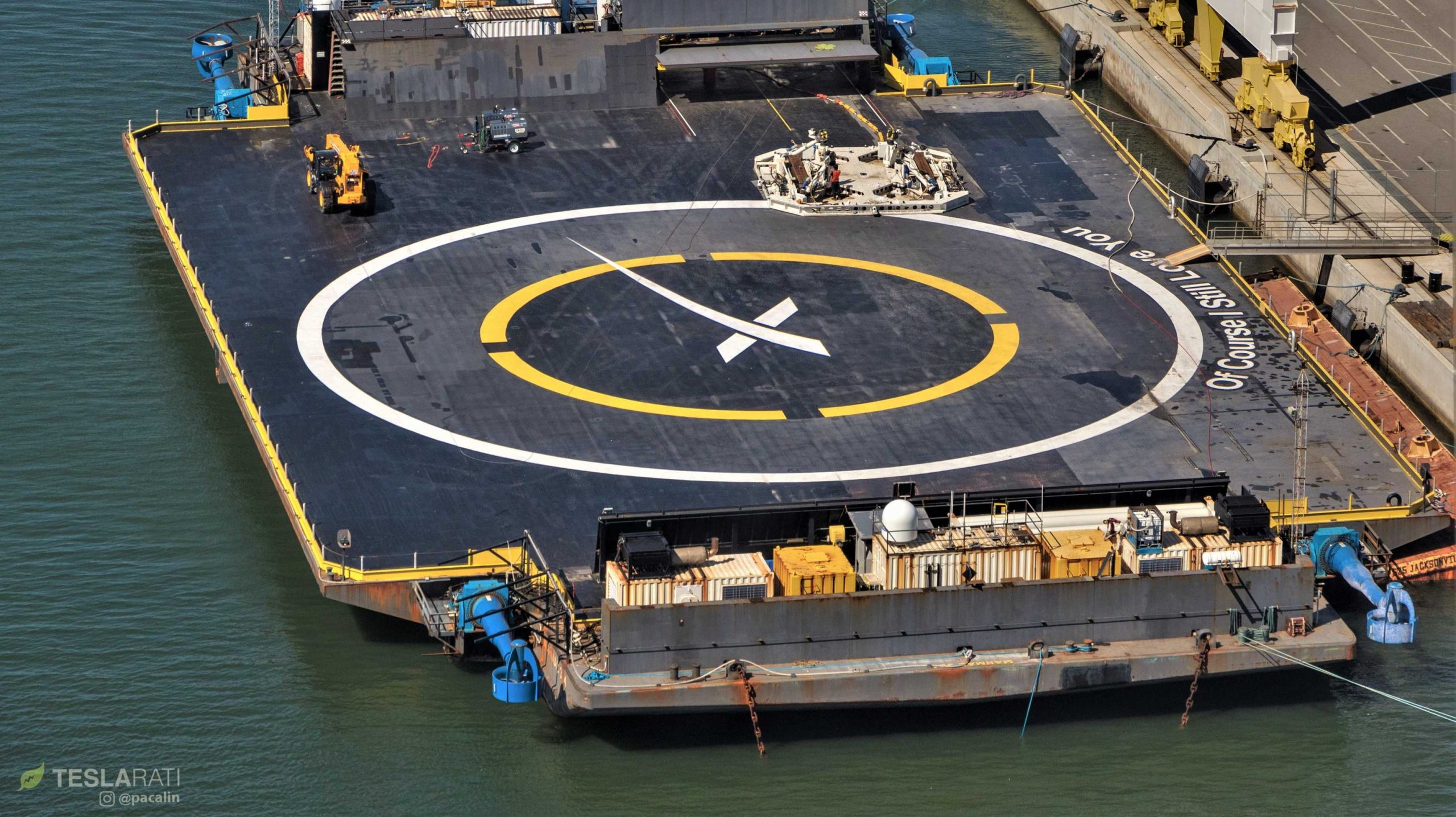
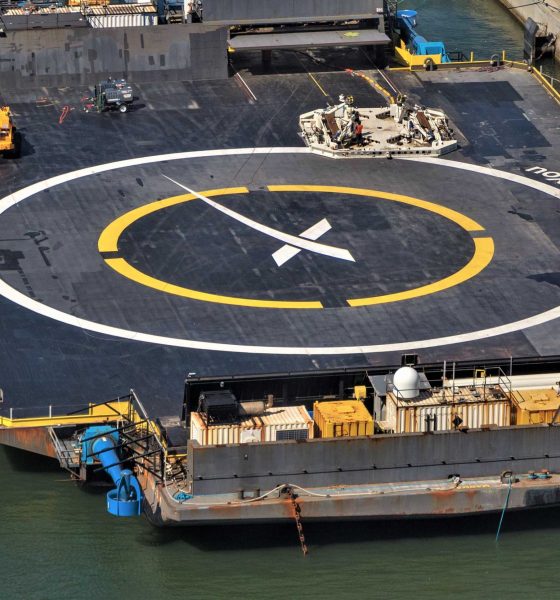
SpaceX
SpaceX’s Falcon 9 recovery robot prepares for imminent rocket landing [photos]
SpaceX’s shadow-bound Falcon 9 recovery robot was spotted out and about aboard drone ship Of Course I Still Love You (OCISLY) in the week leading up to the company’s next rocket launch, targeting liftoff at 8:45 pm EST (01:45 UTC), February 21st.
Dedicated to safely securing Falcon 9 and Heavy boosters after landing aboard drone ship OCISLY, the robot – unofficially nicknamed Octagrabber – uses four hydraulic arms and the sheer mass of its solid steel frame to grab onto the ~25-ton boosters’ built-in launch clamps and hold them steady in sea states that would create a hazard for recovery technicians. Effectively a rocket-grabbing robotic tank, Octagrabber will likely play a role in Falcon 9 B1048’s imminent third launch and landing.
Octagrabber with human for scale. 2/14 #spacex pic.twitter.com/JmUYDJubRm
— Pauline Acalin (@w00ki33) February 15, 2019
While Octagrabber’s work tends to take a backseat to the building-sized rocket landings it precedes, the robot has played an important role in SpaceX’s Falcon 9 recovery efforts since it went into service in mid-2017. Its development was expedited in part because of an iffy 2016 rocket recovery in which the Falcon 9 booster in question – destined to eventually become one of Falcon Heavy’s two side cores – landed hard and wound up precariously sliding around the deck of OCISLY, only saved from falling overboard by the lip of the drone ship’s deck.
- B1023 slid around OCISLY’s deck shortly after launch, nearly falling into the Atlantic. (SpaceX)
- SpaceX’s rocket-securing robot, known as Octagrabber, seen on OCISLY after another successful rocket recovery, August 12th. (Tom Cross)
- Octagrabber hangs on to B1046 as OCISLY arrives in port. (Tom Cross)
With a 25-ton, ~150-foot tall pressurized rocket sliding uncontrollably around their work area, SpaceX’s recovery technicians understandably extricated themselves from the situation and were forced to wait for calmer seas before securing the booster to the deck. Aside from a period of a few months in late 2017 where Octagrabber was effectively incinerated while attempting to secure a Falcon 9 booster with a fuel leak, the robot has been a part of nearly every East Coast Falcon 9 drone ship recovery since. The overall value it adds is unclear but the fact that a similar sibling has yet to be built for West Coast drone ship Just Read The Instructions (JRTI) suggests that Octagrabber is viewed as more of a good option to have with an otherwise non-critical level of utility.
Nevertheless, the lone robot continues to soldier on and is routinely spotted out and about on OCISLY’s deck while the drone ship is docked in Port Canaveral, presumably performing a variety of maintenance checkouts and testing hardware and software between rocket recoveries. While SpaceX’s 2019 launch manifest has had a slow start in January and February, things are expected to get quite a bit more active over the next few months, while a SpaceX executive recently indicated that the company was hoping to conduct 21 or more launches this year.
- (Pauline Acalin)
- (Pauline Acalin)
- Mr. Steven is seen here in Port Canaveral on February 15th, one week before the… accident… (Tom Cross)
Up next on SpaceX’s manifest is a launch just over 12 hours from now, featuring communications satellite PSN-6, an Air Force smallsat, and the first commercial Moon lander. If all goes as planned, the ~5400 kg (11,900 lb) trio will be placed into a high-energy geostationary transfer orbit with an apoapsis around 60,000 km (~38,000 mi) above Earth’s surface. Eight and a half minutes after launch, Falcon 9 B1048 will attempt its third landing in seven months, hopefully setting itself up for a fourth flight (and beyond) later this year. Mr. Steven – having completed a 5000 mile (8000 km) journey just a week and a half prior – will also attempt the first East Coast Falcon fairing catch.
Check out Teslarati’s newsletters for prompt updates, on-the-ground perspectives, and unique glimpses of SpaceX’s rocket launch and recovery processes!

Elon Musk
SpaceX issues statement on Starship V3 Booster 18 anomaly
The incident unfolded during gas-system pressure testing at the company’s Massey facility in Starbase, Texas.

SpaceX has issued an initial statement about Starship Booster 18’s anomaly early Friday. The incident unfolded during gas-system pressure testing at the company’s Massey facility in Starbase, Texas.
SpaceX’s initial comment
As per SpaceX in a post on its official account on social media platform X, Booster 18 was undergoing gas system pressure tests when the anomaly happened. Despite the nature of the incident, the company emphasized that no propellant was loaded, no engines were installed, and personnel were kept at a safe distance from the booster, resulting in zero injuries.
“Booster 18 suffered an anomaly during gas system pressure testing that we were conducting in advance of structural proof testing. No propellant was on the vehicle, and engines were not yet installed. The teams need time to investigate before we are confident of the cause. No one was injured as we maintain a safe distance for personnel during this type of testing. The site remains clear and we are working plans to safely reenter the site,” SpaceX wrote in its post on X.
Incident and aftermath
Livestream footage from LabPadre showed Booster 18’s lower half crumpling around the liquid oxygen tank area at approximately 4:04 a.m. CT. Subsequent images posted by on-site observers revealed extensive deformation across the booster’s lower structure. Needless to say, spaceflight observers have noted that Booster 18 would likely be a complete loss due to its anomaly.
Booster 18 had rolled out only a day earlier and was one of the first vehicles in the Starship V3 program. The V3 series incorporates structural reinforcements and reliability upgrades intended to prepare Starship for rapid-reuse testing and eventual tower-catch operations. Elon Musk has been optimistic about Starship V3, previously noting on X that the spacecraft might be able to complete initial missions to Mars.
Elon Musk
SpaceX Starship Version 3 booster crumples in early testing
Photos of the incident’s aftermath suggest that Booster 18 will likely be retired.
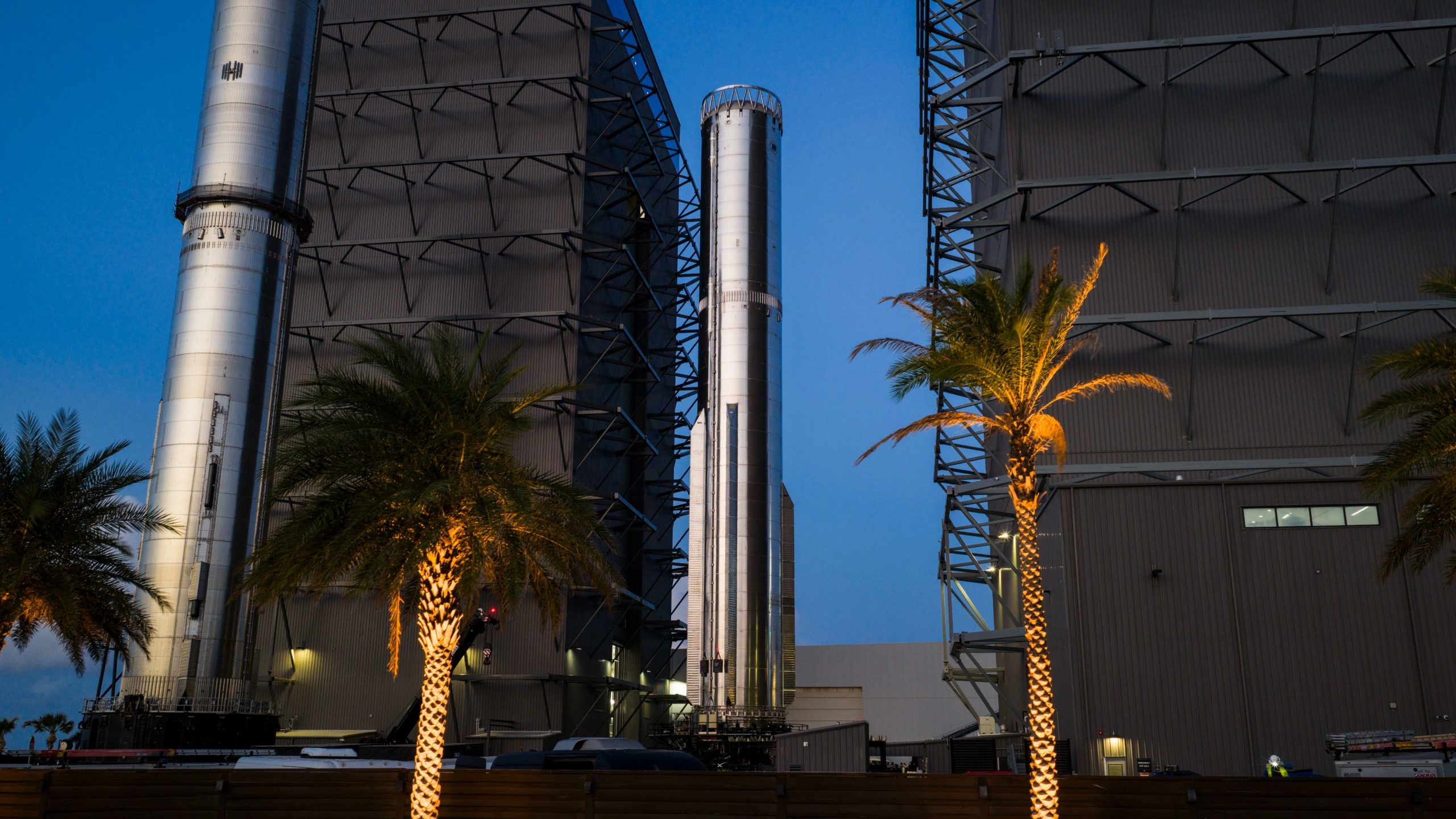
SpaceX’s new Starship first-stage booster, Booster 18, suffered major damage early Friday during its first round of testing in Starbase, Texas, just one day after rolling out of the factory.
Based on videos of the incident, the lower section of the rocket booster appeared to crumple during a pressurization test. Photos of the incident’s aftermath suggest that Booster 18 will likely be retired.
Booster test failure
SpaceX began structural and propellant-system verification tests on Booster 18 Thursday night at the Massey’s Test Site, only a few miles from Starbase’s production facilities, as noted in an Ars Technica report. At 4:04 a.m. CT on Friday, a livestream from LabPadre Space captured the booster’s lower half experiencing a sudden destructive event around its liquid oxygen tank section. Post-incident images, shared on X by @StarshipGazer, showed notable deformation in the booster’s lower structure.
Neither SpaceX nor Elon Musk had commented as of Friday morning, but the vehicle’s condition suggests it is likely a complete loss. This is quite unfortunate, as Booster 18 is already part of the Starship V3 program, which includes design fixes and upgrades intended to improve reliability. While SpaceX maintains a rather rapid Starship production line in Starbase, Booster 18 was generally expected to validate the improvements implemented in the V3 program.
Tight deadlines
SpaceX needs Starship boosters and upper stages to begin demonstrating rapid reuse, tower catches, and early operational Starlink missions over the next two years. More critically, NASA’s Artemis program depends on an on-orbit refueling test in the second half of 2026, a requirement for the vehicle’s expected crewed lunar landing around 2028.
While SpaceX is known for diagnosing failures quickly and returning to testing at unmatched speed, losing the newest-generation booster at the very start of its campaign highlights the immense challenge involved in scaling Starship into a reliable, high-cadence launch system. SpaceX, however, is known for getting things done quickly, so it would not be a surprise if the company manages to figure out what happened to Booster 18 in the near future.
Elon Musk
SpaceX’s next project will produce Starships at a level that sounds impossible
1,000 rockets per year is an insane number, especially considering Starship’s sheer size.
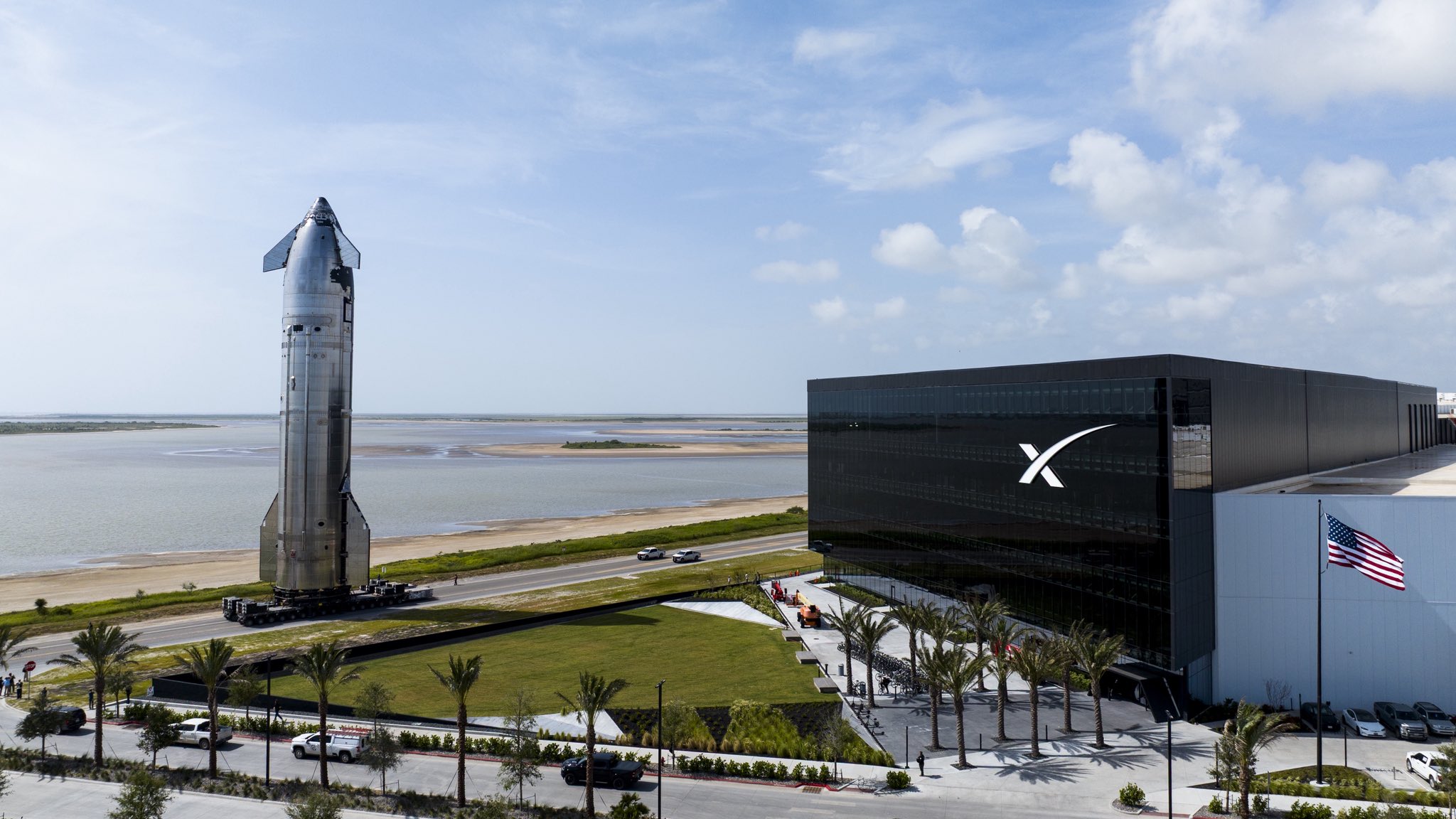
Elon Musk has revealed bold plans for SpaceX’s newest Starbase facility in Texas, predicting it will become a birthplace for “so many spaceships.” The upcoming “Gigabay,” a massive $250 million production hub in Starbase, Texas, is designed to manufacture up to 1,000 Starship rockets per year.
That’s an insane number of rockets for a single facility, especially considering Starship’s sheer size.
One of the world’s largest industrial structures
SpaceX’s Gigabay is expected to stand roughly 380 feet tall and enclose 46.5 million cubic feet of interior space, making it one of the largest industrial structures to date. The facility will feature 24 dedicated work cells for assembling and refurbishing Starship and Super Heavy vehicles, complete with heavy-duty cranes capable of lifting up to 400 U.S. tons, as noted in a Times of India report.
Construction crews have already placed four tower cranes on-site, with completion targeted for December 2026. Once operational, the Gigabay is expected to boost SpaceX’s launch cadence dramatically, as it would be able to build up to 1,000 reusable Starships per year, as noted in a report from the Dallas Express. Musk stated that the Gigabay will be “one of the biggest structures in the world” and hinted that it represents a major leap in Starbase’s evolution from test site to full-scale production hub.
A key step toward Mars and beyond
Starship is SpaceX’s heavy-lift rocket system, and it remains a key part of Elon Musk’s vision of a multiplanetary future. The vehicle can carry 100–150 tonnes to low Earth orbit and up to 250 tonnes in expendable mode. With several successful flights to date, including a perfect 11th test flight, the Starship program continues to refine its reusable launch system ahead of crewed lunar missions under NASA’s Artemis initiative.
Starship is unlike any other spacecraft that has been produced in the past. As per Elon Musk, Starship is a “planet-colonizer” class rocket, as the magnitude of such a task “makes other space transport task trivial.” Considering Starship’s capabilities, it could indeed become the spacecraft that makes a Moon or Mars base feasible.
